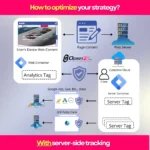Last year, I watched a client struggle with their traditional Google Ads setup. Despite running separate campaigns across Search, Display, YouTube, and Shopping, they couldn’t connect the dots in their customer journey. Meanwhile, their competitors seemed to be everywhere their customers looked. That’s when I introduced them to Performance Max campaigns – and everything changed.
The modern consumer journey isn’t linear anymore. Your potential customers might discover your brand on YouTube, research on Google Search, compare prices on Shopping, and finally convert through a Display remarketing ad. Consequently, managing this complexity manually has become nearly impossible.
What Makes Performance Max Different from Traditional Google Ads
Performance Max represents Google’s most advanced automated campaign type, designed specifically for the multi-touchpoint consumer journey. Unlike traditional campaigns that target individual networks, Performance Max campaigns automatically optimize across all Google ad inventory simultaneously.
Here’s what sets it apart from other campaign types:
- Cross-network automation: Reaches customers across Search, Display, YouTube, Gmail, Discover, and Maps
- AI-driven optimization: Uses Google’s machine learning to find your best customers
- Real-time bidding: Adjusts bids based on conversion likelihood across all touchpoints
- Creative optimization: Automatically tests and combines your assets for maximum performance
In my experience managing over 200 Performance Max campaigns, I’ve seen businesses increase their conversion rates by 15-30% compared to traditional campaign structures. However, success requires understanding how to properly set up and optimize these campaigns.
Performance Max Campaign Setup: The Foundation That Determines Success
Setting up a Performance Max campaign correctly from day one makes the difference between success and frustration. I’ve seen too many businesses rush through setup, only to struggle with poor performance later.
Selecting Campaign Objectives and Conversion Goals
Your campaign objective directly influences how Google’s algorithms optimize your ads. Therefore, choosing the wrong objective can derail your entire campaign before it starts.
For most businesses, I recommend these objective combinations:
- Sales campaigns: Focus on purchase conversions with actual revenue values
- Lead generation: Optimize for form submissions, calls, or other lead actions
- Brand awareness: Target reach and impressions when launching new products
One client in the home improvement industry saw their lead cost drop by 40% simply by switching from a generic “website traffic” objective to properly configured lead generation goals with accurate conversion values.
Budget Strategy and Bid Optimization
Performance Max campaigns require different budget thinking than traditional campaigns. Since Google automatically allocates spending across networks, your budget needs to account for the full customer journey.
I typically recommend starting with these budget guidelines:
- Testing phase: 10x your target cost-per-acquisition for the first 30 days
- Learning period: Maintain consistent daily spend to help algorithms optimize
- Scaling phase: Gradually increase budgets based on performance data
Additionally, the Target ROAS (Return on Ad Spend) bidding strategy works best for most businesses. However, start conservative – if you normally see 4:1 ROAS, set your target at 3:1 initially to give the algorithm room to learn.
Creative Assets and Audience Signals: Where Most Campaigns Win or Lose
The quality of your creative assets directly impacts Performance Max success. Moreover, Google’s AI can only work with what you provide, so mediocre assets lead to mediocre results.
Essential Creative Asset Strategy
Performance Max campaigns require multiple asset types that work together across different ad formats. Based on my testing, here’s what performs best:
Headlines (15 required):
- Include your main keywords in 3-5 headlines
- Add benefit-focused headlines (“Save 30% on Premium Tools”)
- Create urgency-driven options (“Limited Time Offer”)
- Include brand-specific headlines
Descriptions (5 required):
- Focus on unique value propositions
- Include calls-to-action that match your conversion goals
- Highlight key differentiators from competitors
Visual Assets:
- Upload 10-15 high-quality images in various aspect ratios
- Include product shots, lifestyle images, and brand visuals
- Create 3-5 videos showcasing products or services in action
One e-commerce client increased their Performance Max ROAS from 2.8:1 to 5.2:1 simply by refreshing their creative assets with professional product photography and benefit-focused headlines.
Audience Signals That Actually Work
Audience signals help Google’s AI understand your ideal customers during the learning phase. However, many businesses either skip this step or use irrelevant signals.
The most effective audience signals I use include:
- Customer Match lists: Upload your existing customer email lists
- Website visitors: Include users who visited key pages (product pages, pricing, etc.)
- Similar audiences: Let Google find users similar to your best customers
- Custom intent audiences: Target users searching for your specific keywords
Remember, these signals guide initial optimization but don’t limit your reach. Google will expand beyond these audiences once the algorithm identifies patterns.
Performance Max Monitoring and Optimization: Beyond Set-and-Forget
Despite being automated, Performance Max campaigns require consistent monitoring and strategic adjustments. In fact, the most successful campaigns I manage receive weekly optimization attention.
Key Metrics to Monitor Weekly
Focus on these critical performance indicators:
- Search Terms Report: Identify irrelevant queries triggering your ads
- Asset Performance: Find your top-performing headlines and descriptions
- Audience Insights: Understand which customer segments convert best
- Geographic Performance: Optimize location targeting based on results
One B2B client discovered their ads were triggering for completely irrelevant search terms. By adding negative keywords and refining their audience signals, we improved their conversion rate by 25% within two weeks.
Strategic Optimization Techniques
Here are the optimization strategies that deliver the biggest impact:
Asset Rotation: Replace low-performing assets monthly with fresh creative options. Google’s AI performs better with variety.
Conversion Value Optimization: If you’re tracking multiple conversion types, assign accurate values to each. This helps Google prioritize high-value actions.
Seasonal Adjustments: Modify budgets and bids based on seasonal trends in your industry.
For businesses looking to integrate PPC management strategies with their Performance Max campaigns, the key is maintaining consistency across all advertising efforts.
Running Performance Max with Traditional Keyword Campaigns
One common question I get is whether Performance Max conflicts with existing Search campaigns. The answer is nuanced – it depends on your setup strategy.
Performance Max campaigns will compete with your Search campaigns for the same keywords. Therefore, you need a strategic approach:
Campaign Hierarchy Strategy
- Branded campaigns: Keep separate exact match campaigns for your brand terms
- High-intent keywords: Maintain dedicated Search campaigns for your best converting terms
- Discovery and expansion: Let Performance Max handle broader targeting and new customer acquisition
This approach ensures you maintain control over your most important keywords while leveraging Performance Max for growth and discovery.
Budget Allocation Guidelines
Based on my experience with integrated campaign structures:
- Branded Search: 20-25% of total Google Ads budget
- High-intent Search: 35-40% of budget
- Performance Max: 30-35% of budget
- Remarketing/Display: 5-10% of budget
This distribution works for most businesses, but adjust based on your industry and customer journey complexity.
Advanced Performance Max Strategies for 2025
As Google’s AI continues evolving, staying ahead requires understanding emerging optimization techniques. Here are the advanced strategies I’m implementing for clients in 2025:
AI-Powered Asset Creation
Google’s new asset generation features can create headlines and descriptions automatically. While convenient, I recommend using AI-generated assets as starting points, then customizing them with your brand voice and unique value propositions.
The integration of AI-powered SEO strategies with Performance Max campaigns creates powerful synergies for overall digital marketing performance.
Cross-Campaign Data Integration
Performance Max campaigns generate valuable audience insights that can improve your other marketing channels. Export high-converting audience segments and use them for:
- Facebook and Instagram advertising
- Email marketing segmentation
- Content personalization on your website
- SEO content creation based on converting keywords
Common Performance Max Mistakes to Avoid
After managing hundreds of Performance Max campaigns, I’ve identified the most common mistakes that hurt performance:
Insufficient Learning Period: Changing settings daily prevents algorithms from optimizing effectively. Give campaigns at least 2-3 weeks to learn.
Generic Asset Groups: Creating one asset group for all products dilutes performance. Instead, create separate asset groups for different product categories or customer segments.
Ignoring Negative Keywords: Even automated campaigns need negative keyword management to prevent irrelevant traffic.
Poor Conversion Tracking: Inaccurate conversion data leads to poor optimization. Ensure your tracking is properly configured before launching.
Understanding how return on investment calculations work with Performance Max campaigns helps set realistic expectations and measure true success.
Measuring Performance Max Success
Success metrics for Performance Max campaigns extend beyond simple ROAS or conversion counts. Focus on these comprehensive performance indicators:
- Customer Lifetime Value: Track long-term customer value, not just initial conversions
- Cross-Channel Attribution: Understand how Performance Max assists conversions in other channels
- Market Share Growth: Monitor your share of relevant searches and impressions
- Brand Awareness Metrics: Track branded search volume increases
One client saw their branded search volume increase by 45% after running Performance Max campaigns for three months, indicating significant brand awareness improvement beyond direct conversions.
Performance Max in Different Industries
Performance Max campaigns work across industries, but optimization strategies vary significantly. Here’s what I’ve learned from managing campaigns in different sectors:
E-commerce: Focus heavily on product feed optimization and seasonal bidding adjustments. Shopping campaigns integration is crucial.
B2B Services: Emphasize lead quality over quantity. Use longer conversion windows and focus on content-rich landing pages.
Local Businesses: Integrate with Google My Business and focus on location-based audience signals. Store visits become important conversion metrics.
The key is adapting your Performance Max strategy to your specific business model and customer journey while maintaining the core optimization principles.
Future of Performance Max Campaigns
Google continues expanding Performance Max capabilities, and staying current with updates ensures optimal performance. Recent developments include:
- Enhanced local campaign features for brick-and-mortar businesses
- Improved video asset optimization across YouTube inventory
- Better integration with Google Analytics 4 for conversion tracking
- Advanced audience signal options for B2B targeting
Additionally, the integration of machine learning with traditional marketing approaches, as discussed in our machine learning for SEO guide, creates opportunities for more sophisticated campaign optimization.
Performance Max campaigns represent the future of digital advertising – automated, intelligent, and designed for the complex modern consumer journey. However, success still requires strategic thinking, quality creative assets, and consistent optimization. When implemented correctly, these campaigns can significantly improve your advertising efficiency while reducing the complexity of managing multiple campaign types.
The key is starting with solid fundamentals: clear objectives, quality creative assets, accurate tracking, and realistic expectations. From there, continuous testing and optimization will drive long-term success.
Frequently Asked Questions
How long does it take for Performance Max campaigns to optimize and show results?
Performance Max campaigns typically need 2-4 weeks to complete their learning phase and show stable performance. During this time, Google’s AI analyzes your audience signals, tests creative combinations, and identifies the best conversion opportunities across all networks. I recommend maintaining consistent budgets and avoiding major changes during this critical learning period.
Can I run Performance Max campaigns alongside my existing Google Ads campaigns without conflicts?
Yes, but strategic planning is essential to avoid internal competition. Performance Max campaigns will compete with your Search campaigns for the same keywords, so I recommend maintaining separate exact match campaigns for branded terms and high-converting keywords while letting Performance Max handle broader targeting and new customer discovery. Proper campaign hierarchy prevents budget cannibalization.
What’s the minimum budget needed to run effective Performance Max campaigns?
While Google doesn’t set minimum budgets, I recommend at least $1,000-$2,000 monthly for most businesses to generate sufficient data for optimization. The key is having enough budget to achieve 15-20 conversions during the learning phase. Smaller budgets can work for businesses with lower-cost products or services, but may require longer optimization periods to see meaningful results.
 Written by: Romulo Vargas Betancourt
Written by: Romulo Vargas Betancourt
CEO – OpenFS LLC







